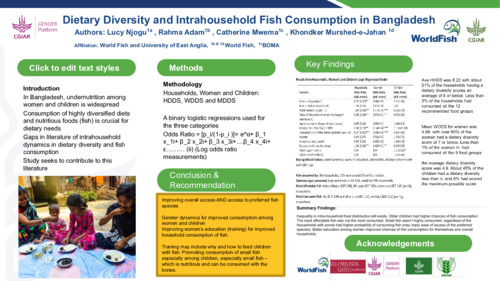Intrahousehold dietary diversity and determinants of fish consumption in Bangladesh
Abstract
Malnutrition undermines an individual’s quality of life and has far-reaching impact on a country’s economy. In Bangladesh, malnutrition among women and children is widespread. Consumption of low-nutrient foods, limited dietary diversity and discrimination in intrahousehold food allocation are often reported as common cause of malnutrition among the vulnerable in the household. Although the government of Bangladesh has put in effort in eradicating malnutrition, the reduction rate is still very low. Given the high nutrient level of fish, it is considered an invaluable tool in fighting malnutrition. To inform policy and initiatives in malnutrition eradication, we assess the intrahousehold dietary levels among general households, women and children. Data was collected from 2,669 households in Rangpur and Rajshahi divisions of Bangladesh. Results indicate that the fish species with the lowest price was not the most consumed species. Also, while almost all households consumed fish, but about 30% of women and children in those households did not consume fish. Similarly, women and children recorded a lower dietary diversity score compared to the households. Consumption of fish among children was influenced by age and gender. Among women and general households, some of the factors which influenced fish consumption included pond ownership, distance to the market and consumption of other animal proteins. Increases in fish price increased the odds of fish consumption. These results indicate the need for development initiatives and food policies adopt targeted strategies in promoting fish consumption for nutritional security.

